Edexcel BTEC Level 7 Strategic Management and Leadership Report
VerifiedAdded on 2020/01/15
|11
|3387
|191
Report
AI Summary
This report delves into the critical aspects of strategic management and leadership skills, focusing on a case study of Nexus Ltd, a London-based consultancy firm. It explores the interplay between strategic management and leadership, analyzing the influence of various leadership styles, such as authoritarian, democratic, and laissez-faire, on strategic decision-making within organizations like Hilton Hotel and InterContinental Hotel Group. The report evaluates the adaptation of leadership styles in different situations and reviews the application of management and leadership theories including System Theory, Contingency Theory, Great Man Theory, and Behavioral Theory. Furthermore, it examines the impact of these theories on organizational performance and culminates in the creation of a leadership strategy for Apple, incorporating leadership theories to support its current and future direction, including SWOT and PESTELEC analyses.
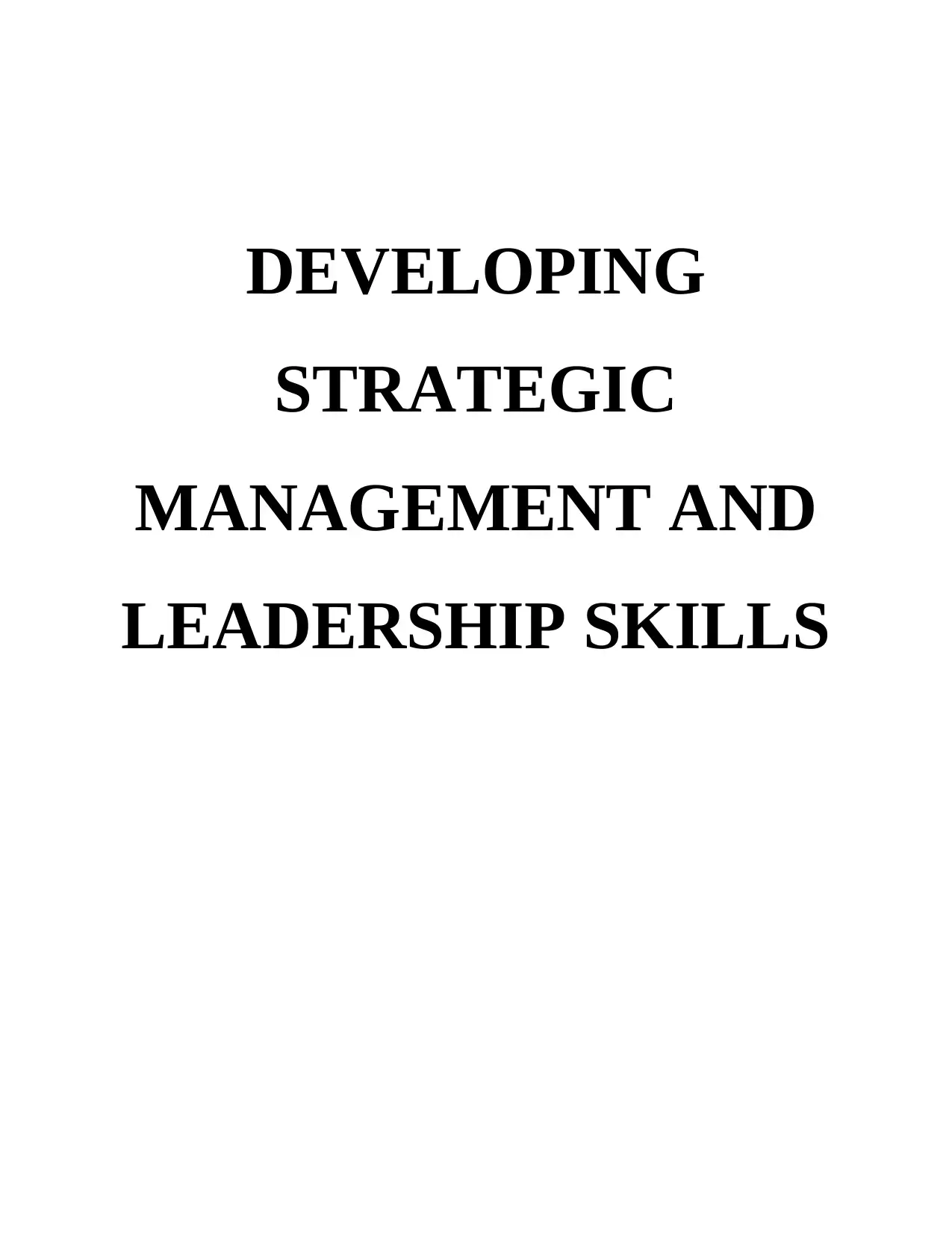
DEVELOPING
STRATEGIC
MANAGEMENT AND
LEADERSHIP SKILLS
STRATEGIC
MANAGEMENT AND
LEADERSHIP SKILLS
Paraphrase This Document
Need a fresh take? Get an instant paraphrase of this document with our AI Paraphraser
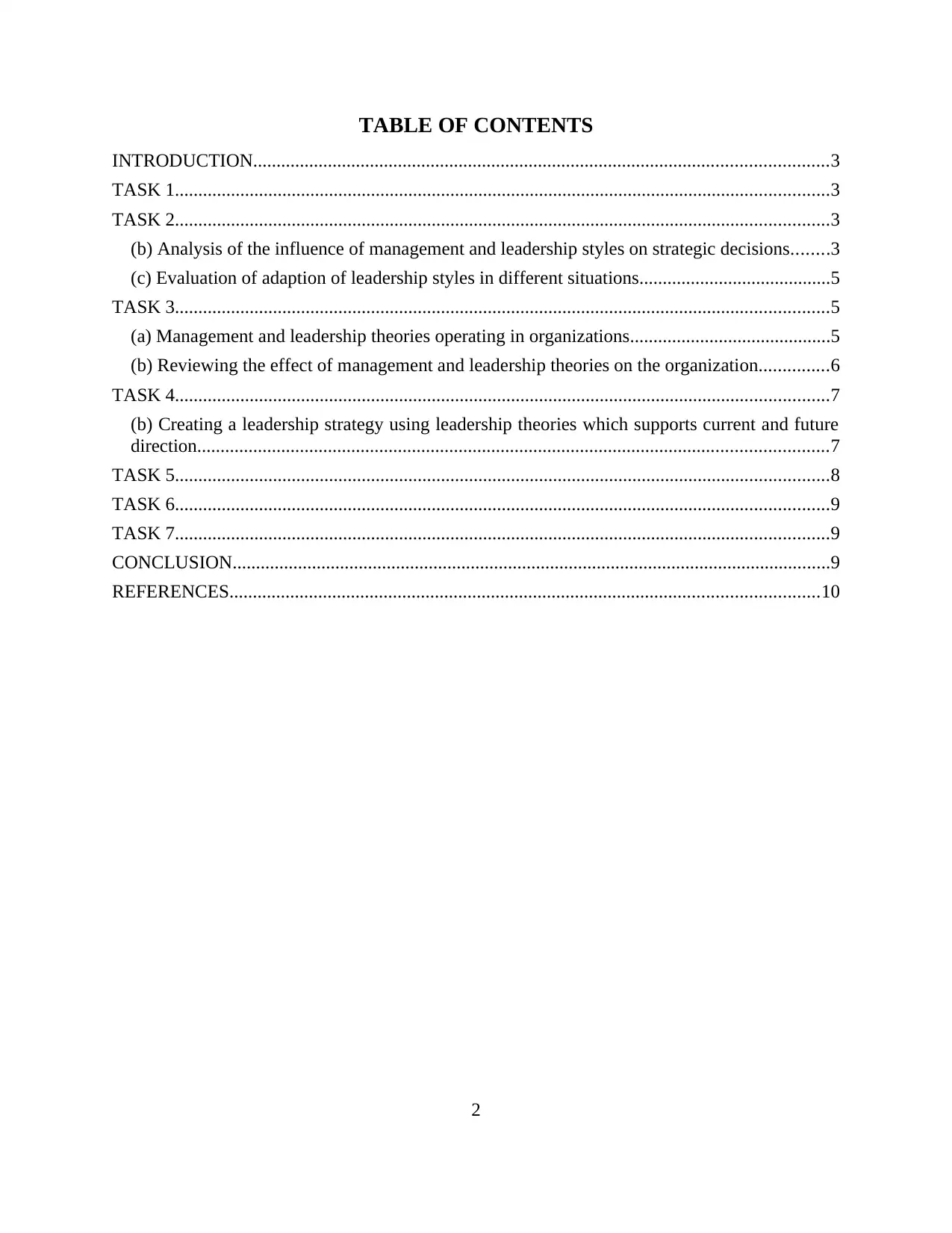
TABLE OF CONTENTS
INTRODUCTION...........................................................................................................................3
TASK 1............................................................................................................................................3
TASK 2............................................................................................................................................3
(b) Analysis of the influence of management and leadership styles on strategic decisions........3
(c) Evaluation of adaption of leadership styles in different situations.........................................5
TASK 3............................................................................................................................................5
(a) Management and leadership theories operating in organizations...........................................5
(b) Reviewing the effect of management and leadership theories on the organization...............6
TASK 4............................................................................................................................................7
(b) Creating a leadership strategy using leadership theories which supports current and future
direction.......................................................................................................................................7
TASK 5............................................................................................................................................8
TASK 6............................................................................................................................................9
TASK 7............................................................................................................................................9
CONCLUSION................................................................................................................................9
REFERENCES..............................................................................................................................10
2
INTRODUCTION...........................................................................................................................3
TASK 1............................................................................................................................................3
TASK 2............................................................................................................................................3
(b) Analysis of the influence of management and leadership styles on strategic decisions........3
(c) Evaluation of adaption of leadership styles in different situations.........................................5
TASK 3............................................................................................................................................5
(a) Management and leadership theories operating in organizations...........................................5
(b) Reviewing the effect of management and leadership theories on the organization...............6
TASK 4............................................................................................................................................7
(b) Creating a leadership strategy using leadership theories which supports current and future
direction.......................................................................................................................................7
TASK 5............................................................................................................................................8
TASK 6............................................................................................................................................9
TASK 7............................................................................................................................................9
CONCLUSION................................................................................................................................9
REFERENCES..............................................................................................................................10
2
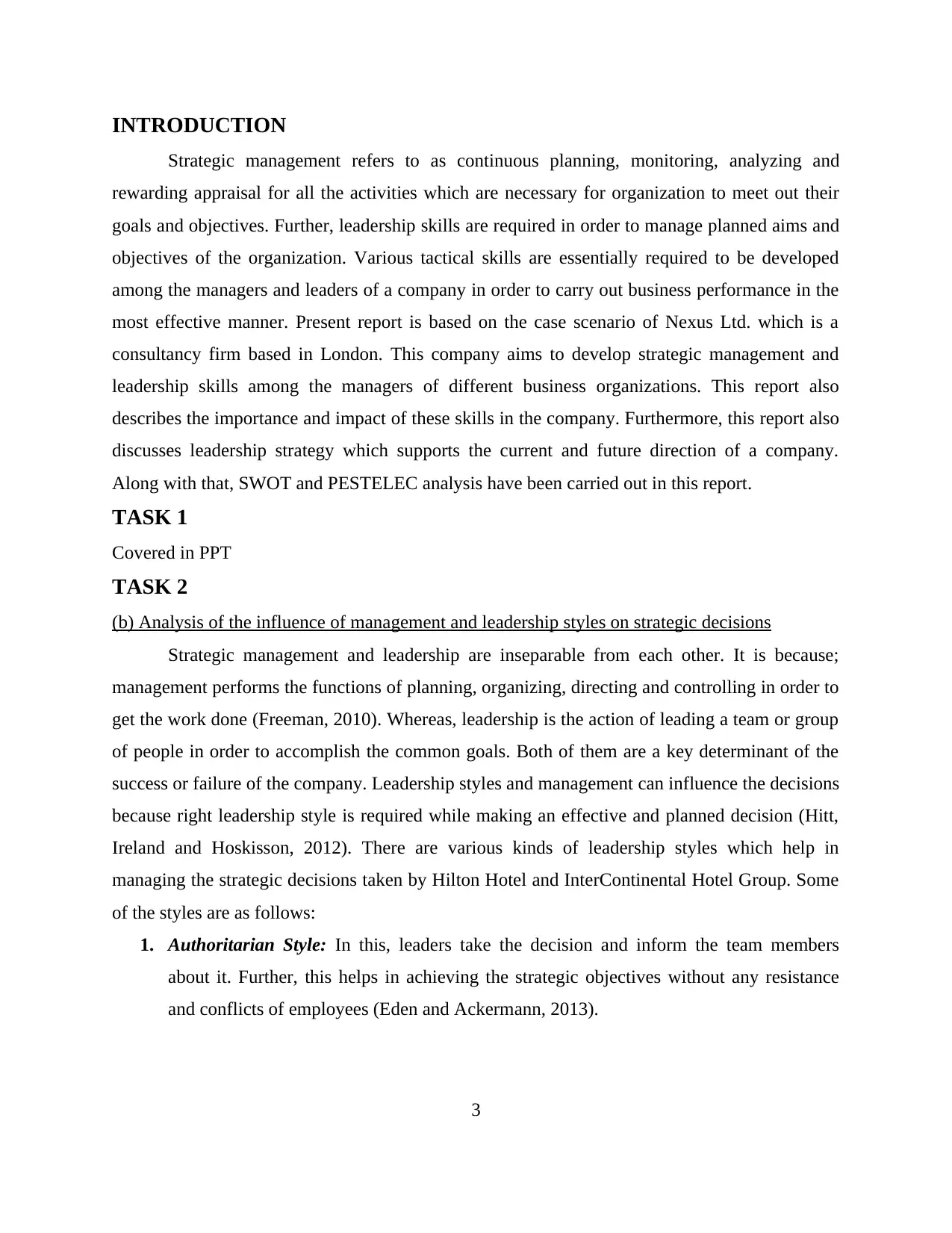
INTRODUCTION
Strategic management refers to as continuous planning, monitoring, analyzing and
rewarding appraisal for all the activities which are necessary for organization to meet out their
goals and objectives. Further, leadership skills are required in order to manage planned aims and
objectives of the organization. Various tactical skills are essentially required to be developed
among the managers and leaders of a company in order to carry out business performance in the
most effective manner. Present report is based on the case scenario of Nexus Ltd. which is a
consultancy firm based in London. This company aims to develop strategic management and
leadership skills among the managers of different business organizations. This report also
describes the importance and impact of these skills in the company. Furthermore, this report also
discusses leadership strategy which supports the current and future direction of a company.
Along with that, SWOT and PESTELEC analysis have been carried out in this report.
TASK 1
Covered in PPT
TASK 2
(b) Analysis of the influence of management and leadership styles on strategic decisions
Strategic management and leadership are inseparable from each other. It is because;
management performs the functions of planning, organizing, directing and controlling in order to
get the work done (Freeman, 2010). Whereas, leadership is the action of leading a team or group
of people in order to accomplish the common goals. Both of them are a key determinant of the
success or failure of the company. Leadership styles and management can influence the decisions
because right leadership style is required while making an effective and planned decision (Hitt,
Ireland and Hoskisson, 2012). There are various kinds of leadership styles which help in
managing the strategic decisions taken by Hilton Hotel and InterContinental Hotel Group. Some
of the styles are as follows:
1. Authoritarian Style: In this, leaders take the decision and inform the team members
about it. Further, this helps in achieving the strategic objectives without any resistance
and conflicts of employees (Eden and Ackermann, 2013).
3
Strategic management refers to as continuous planning, monitoring, analyzing and
rewarding appraisal for all the activities which are necessary for organization to meet out their
goals and objectives. Further, leadership skills are required in order to manage planned aims and
objectives of the organization. Various tactical skills are essentially required to be developed
among the managers and leaders of a company in order to carry out business performance in the
most effective manner. Present report is based on the case scenario of Nexus Ltd. which is a
consultancy firm based in London. This company aims to develop strategic management and
leadership skills among the managers of different business organizations. This report also
describes the importance and impact of these skills in the company. Furthermore, this report also
discusses leadership strategy which supports the current and future direction of a company.
Along with that, SWOT and PESTELEC analysis have been carried out in this report.
TASK 1
Covered in PPT
TASK 2
(b) Analysis of the influence of management and leadership styles on strategic decisions
Strategic management and leadership are inseparable from each other. It is because;
management performs the functions of planning, organizing, directing and controlling in order to
get the work done (Freeman, 2010). Whereas, leadership is the action of leading a team or group
of people in order to accomplish the common goals. Both of them are a key determinant of the
success or failure of the company. Leadership styles and management can influence the decisions
because right leadership style is required while making an effective and planned decision (Hitt,
Ireland and Hoskisson, 2012). There are various kinds of leadership styles which help in
managing the strategic decisions taken by Hilton Hotel and InterContinental Hotel Group. Some
of the styles are as follows:
1. Authoritarian Style: In this, leaders take the decision and inform the team members
about it. Further, this helps in achieving the strategic objectives without any resistance
and conflicts of employees (Eden and Ackermann, 2013).
3
⊘ This is a preview!⊘
Do you want full access?
Subscribe today to unlock all pages.

Trusted by 1+ million students worldwide
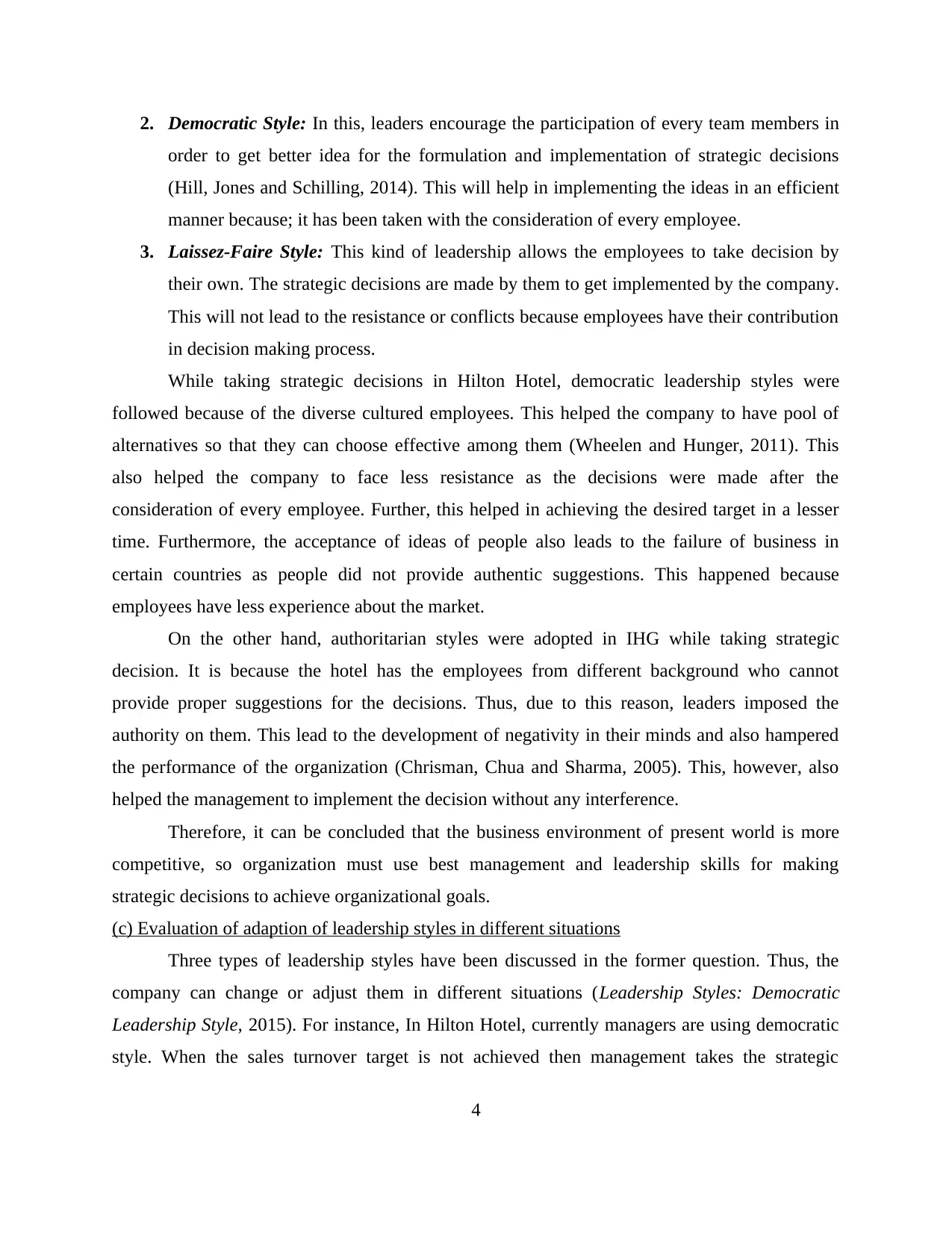
2. Democratic Style: In this, leaders encourage the participation of every team members in
order to get better idea for the formulation and implementation of strategic decisions
(Hill, Jones and Schilling, 2014). This will help in implementing the ideas in an efficient
manner because; it has been taken with the consideration of every employee.
3. Laissez-Faire Style: This kind of leadership allows the employees to take decision by
their own. The strategic decisions are made by them to get implemented by the company.
This will not lead to the resistance or conflicts because employees have their contribution
in decision making process.
While taking strategic decisions in Hilton Hotel, democratic leadership styles were
followed because of the diverse cultured employees. This helped the company to have pool of
alternatives so that they can choose effective among them (Wheelen and Hunger, 2011). This
also helped the company to face less resistance as the decisions were made after the
consideration of every employee. Further, this helped in achieving the desired target in a lesser
time. Furthermore, the acceptance of ideas of people also leads to the failure of business in
certain countries as people did not provide authentic suggestions. This happened because
employees have less experience about the market.
On the other hand, authoritarian styles were adopted in IHG while taking strategic
decision. It is because the hotel has the employees from different background who cannot
provide proper suggestions for the decisions. Thus, due to this reason, leaders imposed the
authority on them. This lead to the development of negativity in their minds and also hampered
the performance of the organization (Chrisman, Chua and Sharma, 2005). This, however, also
helped the management to implement the decision without any interference.
Therefore, it can be concluded that the business environment of present world is more
competitive, so organization must use best management and leadership skills for making
strategic decisions to achieve organizational goals.
(c) Evaluation of adaption of leadership styles in different situations
Three types of leadership styles have been discussed in the former question. Thus, the
company can change or adjust them in different situations (Leadership Styles: Democratic
Leadership Style, 2015). For instance, In Hilton Hotel, currently managers are using democratic
style. When the sales turnover target is not achieved then management takes the strategic
4
order to get better idea for the formulation and implementation of strategic decisions
(Hill, Jones and Schilling, 2014). This will help in implementing the ideas in an efficient
manner because; it has been taken with the consideration of every employee.
3. Laissez-Faire Style: This kind of leadership allows the employees to take decision by
their own. The strategic decisions are made by them to get implemented by the company.
This will not lead to the resistance or conflicts because employees have their contribution
in decision making process.
While taking strategic decisions in Hilton Hotel, democratic leadership styles were
followed because of the diverse cultured employees. This helped the company to have pool of
alternatives so that they can choose effective among them (Wheelen and Hunger, 2011). This
also helped the company to face less resistance as the decisions were made after the
consideration of every employee. Further, this helped in achieving the desired target in a lesser
time. Furthermore, the acceptance of ideas of people also leads to the failure of business in
certain countries as people did not provide authentic suggestions. This happened because
employees have less experience about the market.
On the other hand, authoritarian styles were adopted in IHG while taking strategic
decision. It is because the hotel has the employees from different background who cannot
provide proper suggestions for the decisions. Thus, due to this reason, leaders imposed the
authority on them. This lead to the development of negativity in their minds and also hampered
the performance of the organization (Chrisman, Chua and Sharma, 2005). This, however, also
helped the management to implement the decision without any interference.
Therefore, it can be concluded that the business environment of present world is more
competitive, so organization must use best management and leadership skills for making
strategic decisions to achieve organizational goals.
(c) Evaluation of adaption of leadership styles in different situations
Three types of leadership styles have been discussed in the former question. Thus, the
company can change or adjust them in different situations (Leadership Styles: Democratic
Leadership Style, 2015). For instance, In Hilton Hotel, currently managers are using democratic
style. When the sales turnover target is not achieved then management takes the strategic
4
Paraphrase This Document
Need a fresh take? Get an instant paraphrase of this document with our AI Paraphraser
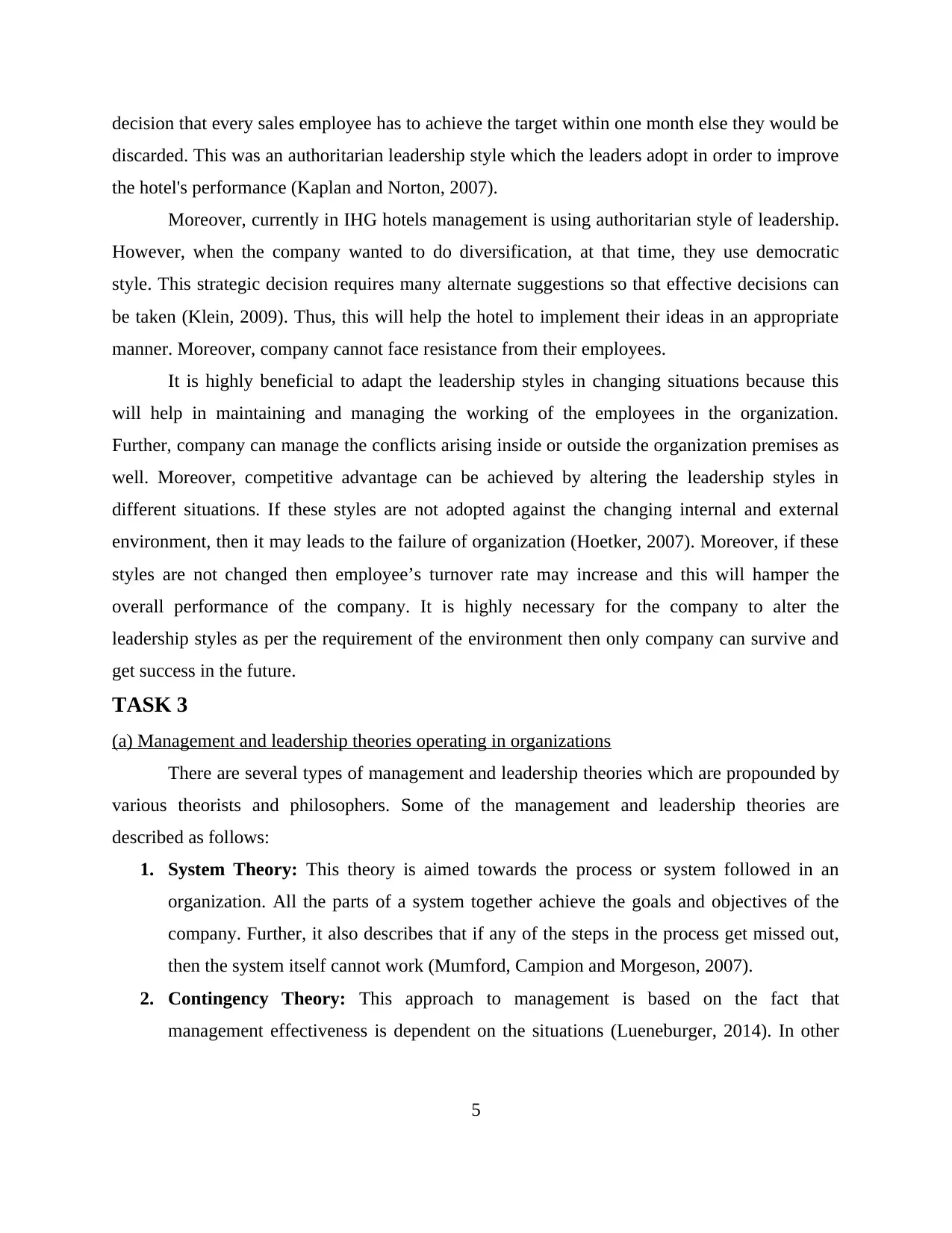
decision that every sales employee has to achieve the target within one month else they would be
discarded. This was an authoritarian leadership style which the leaders adopt in order to improve
the hotel's performance (Kaplan and Norton, 2007).
Moreover, currently in IHG hotels management is using authoritarian style of leadership.
However, when the company wanted to do diversification, at that time, they use democratic
style. This strategic decision requires many alternate suggestions so that effective decisions can
be taken (Klein, 2009). Thus, this will help the hotel to implement their ideas in an appropriate
manner. Moreover, company cannot face resistance from their employees.
It is highly beneficial to adapt the leadership styles in changing situations because this
will help in maintaining and managing the working of the employees in the organization.
Further, company can manage the conflicts arising inside or outside the organization premises as
well. Moreover, competitive advantage can be achieved by altering the leadership styles in
different situations. If these styles are not adopted against the changing internal and external
environment, then it may leads to the failure of organization (Hoetker, 2007). Moreover, if these
styles are not changed then employee’s turnover rate may increase and this will hamper the
overall performance of the company. It is highly necessary for the company to alter the
leadership styles as per the requirement of the environment then only company can survive and
get success in the future.
TASK 3
(a) Management and leadership theories operating in organizations
There are several types of management and leadership theories which are propounded by
various theorists and philosophers. Some of the management and leadership theories are
described as follows:
1. System Theory: This theory is aimed towards the process or system followed in an
organization. All the parts of a system together achieve the goals and objectives of the
company. Further, it also describes that if any of the steps in the process get missed out,
then the system itself cannot work (Mumford, Campion and Morgeson, 2007).
2. Contingency Theory: This approach to management is based on the fact that
management effectiveness is dependent on the situations (Lueneburger, 2014). In other
5
discarded. This was an authoritarian leadership style which the leaders adopt in order to improve
the hotel's performance (Kaplan and Norton, 2007).
Moreover, currently in IHG hotels management is using authoritarian style of leadership.
However, when the company wanted to do diversification, at that time, they use democratic
style. This strategic decision requires many alternate suggestions so that effective decisions can
be taken (Klein, 2009). Thus, this will help the hotel to implement their ideas in an appropriate
manner. Moreover, company cannot face resistance from their employees.
It is highly beneficial to adapt the leadership styles in changing situations because this
will help in maintaining and managing the working of the employees in the organization.
Further, company can manage the conflicts arising inside or outside the organization premises as
well. Moreover, competitive advantage can be achieved by altering the leadership styles in
different situations. If these styles are not adopted against the changing internal and external
environment, then it may leads to the failure of organization (Hoetker, 2007). Moreover, if these
styles are not changed then employee’s turnover rate may increase and this will hamper the
overall performance of the company. It is highly necessary for the company to alter the
leadership styles as per the requirement of the environment then only company can survive and
get success in the future.
TASK 3
(a) Management and leadership theories operating in organizations
There are several types of management and leadership theories which are propounded by
various theorists and philosophers. Some of the management and leadership theories are
described as follows:
1. System Theory: This theory is aimed towards the process or system followed in an
organization. All the parts of a system together achieve the goals and objectives of the
company. Further, it also describes that if any of the steps in the process get missed out,
then the system itself cannot work (Mumford, Campion and Morgeson, 2007).
2. Contingency Theory: This approach to management is based on the fact that
management effectiveness is dependent on the situations (Lueneburger, 2014). In other
5
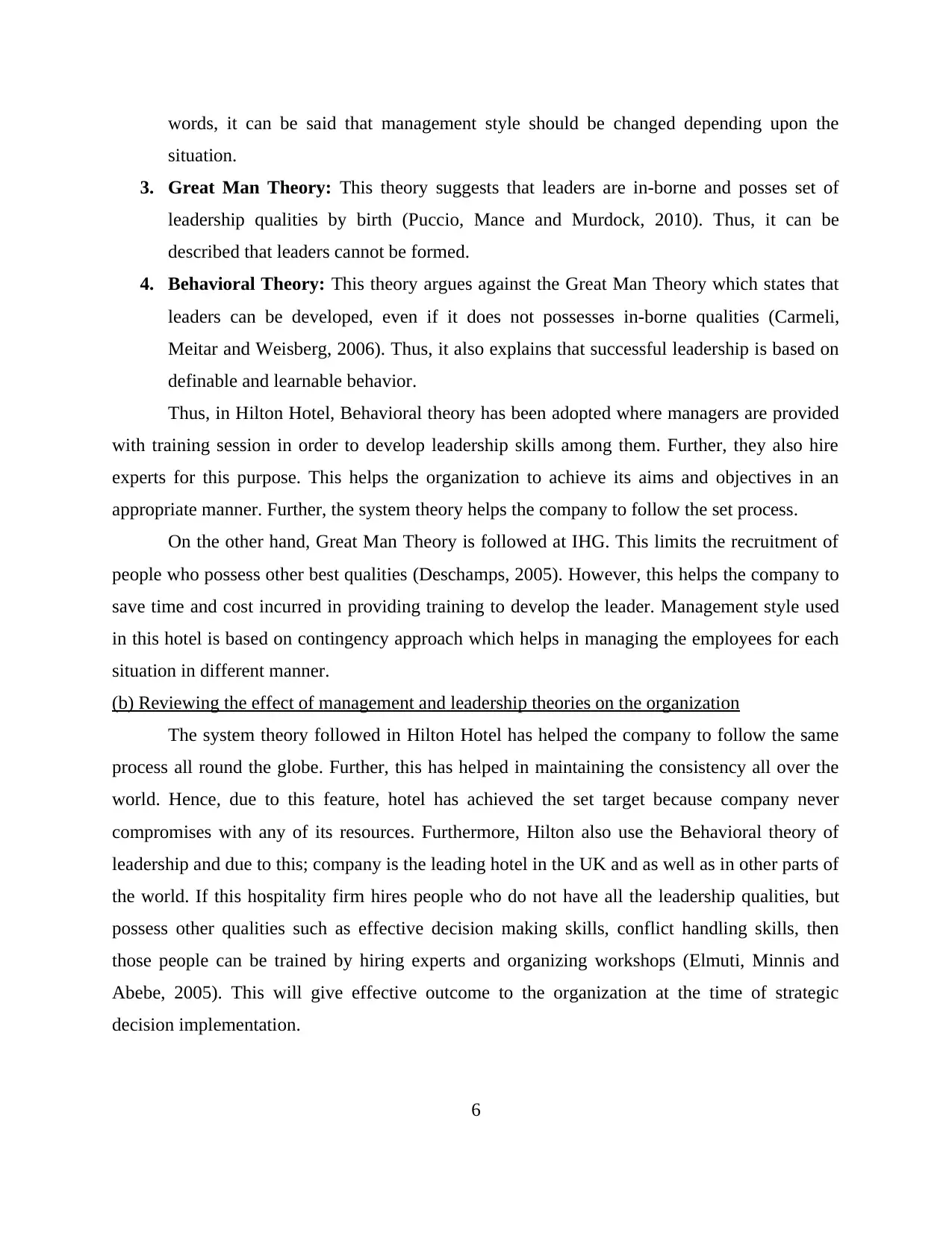
words, it can be said that management style should be changed depending upon the
situation.
3. Great Man Theory: This theory suggests that leaders are in-borne and posses set of
leadership qualities by birth (Puccio, Mance and Murdock, 2010). Thus, it can be
described that leaders cannot be formed.
4. Behavioral Theory: This theory argues against the Great Man Theory which states that
leaders can be developed, even if it does not possesses in-borne qualities (Carmeli,
Meitar and Weisberg, 2006). Thus, it also explains that successful leadership is based on
definable and learnable behavior.
Thus, in Hilton Hotel, Behavioral theory has been adopted where managers are provided
with training session in order to develop leadership skills among them. Further, they also hire
experts for this purpose. This helps the organization to achieve its aims and objectives in an
appropriate manner. Further, the system theory helps the company to follow the set process.
On the other hand, Great Man Theory is followed at IHG. This limits the recruitment of
people who possess other best qualities (Deschamps, 2005). However, this helps the company to
save time and cost incurred in providing training to develop the leader. Management style used
in this hotel is based on contingency approach which helps in managing the employees for each
situation in different manner.
(b) Reviewing the effect of management and leadership theories on the organization
The system theory followed in Hilton Hotel has helped the company to follow the same
process all round the globe. Further, this has helped in maintaining the consistency all over the
world. Hence, due to this feature, hotel has achieved the set target because company never
compromises with any of its resources. Furthermore, Hilton also use the Behavioral theory of
leadership and due to this; company is the leading hotel in the UK and as well as in other parts of
the world. If this hospitality firm hires people who do not have all the leadership qualities, but
possess other qualities such as effective decision making skills, conflict handling skills, then
those people can be trained by hiring experts and organizing workshops (Elmuti, Minnis and
Abebe, 2005). This will give effective outcome to the organization at the time of strategic
decision implementation.
6
situation.
3. Great Man Theory: This theory suggests that leaders are in-borne and posses set of
leadership qualities by birth (Puccio, Mance and Murdock, 2010). Thus, it can be
described that leaders cannot be formed.
4. Behavioral Theory: This theory argues against the Great Man Theory which states that
leaders can be developed, even if it does not possesses in-borne qualities (Carmeli,
Meitar and Weisberg, 2006). Thus, it also explains that successful leadership is based on
definable and learnable behavior.
Thus, in Hilton Hotel, Behavioral theory has been adopted where managers are provided
with training session in order to develop leadership skills among them. Further, they also hire
experts for this purpose. This helps the organization to achieve its aims and objectives in an
appropriate manner. Further, the system theory helps the company to follow the set process.
On the other hand, Great Man Theory is followed at IHG. This limits the recruitment of
people who possess other best qualities (Deschamps, 2005). However, this helps the company to
save time and cost incurred in providing training to develop the leader. Management style used
in this hotel is based on contingency approach which helps in managing the employees for each
situation in different manner.
(b) Reviewing the effect of management and leadership theories on the organization
The system theory followed in Hilton Hotel has helped the company to follow the same
process all round the globe. Further, this has helped in maintaining the consistency all over the
world. Hence, due to this feature, hotel has achieved the set target because company never
compromises with any of its resources. Furthermore, Hilton also use the Behavioral theory of
leadership and due to this; company is the leading hotel in the UK and as well as in other parts of
the world. If this hospitality firm hires people who do not have all the leadership qualities, but
possess other qualities such as effective decision making skills, conflict handling skills, then
those people can be trained by hiring experts and organizing workshops (Elmuti, Minnis and
Abebe, 2005). This will give effective outcome to the organization at the time of strategic
decision implementation.
6
⊘ This is a preview!⊘
Do you want full access?
Subscribe today to unlock all pages.

Trusted by 1+ million students worldwide
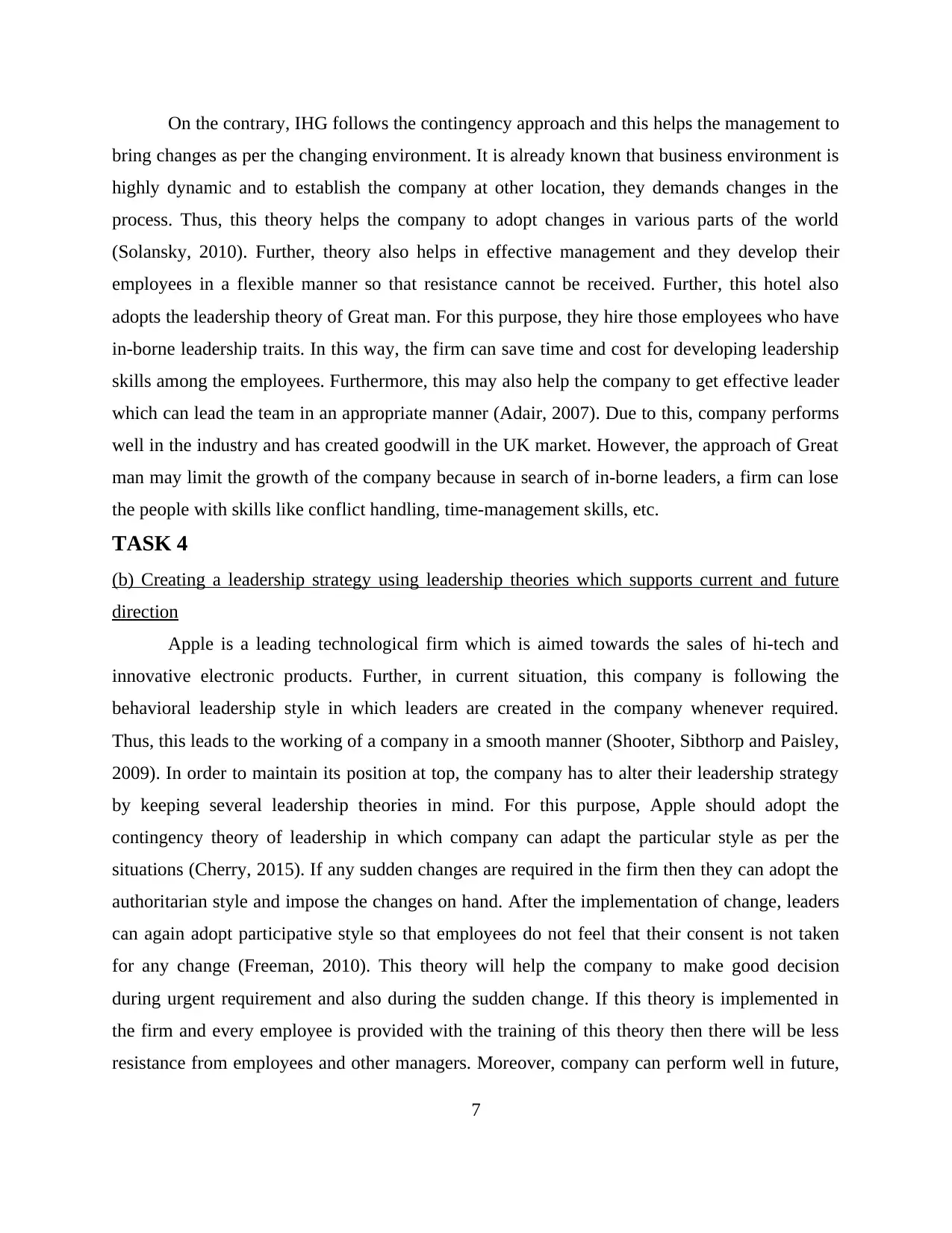
On the contrary, IHG follows the contingency approach and this helps the management to
bring changes as per the changing environment. It is already known that business environment is
highly dynamic and to establish the company at other location, they demands changes in the
process. Thus, this theory helps the company to adopt changes in various parts of the world
(Solansky, 2010). Further, theory also helps in effective management and they develop their
employees in a flexible manner so that resistance cannot be received. Further, this hotel also
adopts the leadership theory of Great man. For this purpose, they hire those employees who have
in-borne leadership traits. In this way, the firm can save time and cost for developing leadership
skills among the employees. Furthermore, this may also help the company to get effective leader
which can lead the team in an appropriate manner (Adair, 2007). Due to this, company performs
well in the industry and has created goodwill in the UK market. However, the approach of Great
man may limit the growth of the company because in search of in-borne leaders, a firm can lose
the people with skills like conflict handling, time-management skills, etc.
TASK 4
(b) Creating a leadership strategy using leadership theories which supports current and future
direction
Apple is a leading technological firm which is aimed towards the sales of hi-tech and
innovative electronic products. Further, in current situation, this company is following the
behavioral leadership style in which leaders are created in the company whenever required.
Thus, this leads to the working of a company in a smooth manner (Shooter, Sibthorp and Paisley,
2009). In order to maintain its position at top, the company has to alter their leadership strategy
by keeping several leadership theories in mind. For this purpose, Apple should adopt the
contingency theory of leadership in which company can adapt the particular style as per the
situations (Cherry, 2015). If any sudden changes are required in the firm then they can adopt the
authoritarian style and impose the changes on hand. After the implementation of change, leaders
can again adopt participative style so that employees do not feel that their consent is not taken
for any change (Freeman, 2010). This theory will help the company to make good decision
during urgent requirement and also during the sudden change. If this theory is implemented in
the firm and every employee is provided with the training of this theory then there will be less
resistance from employees and other managers. Moreover, company can perform well in future,
7
bring changes as per the changing environment. It is already known that business environment is
highly dynamic and to establish the company at other location, they demands changes in the
process. Thus, this theory helps the company to adopt changes in various parts of the world
(Solansky, 2010). Further, theory also helps in effective management and they develop their
employees in a flexible manner so that resistance cannot be received. Further, this hotel also
adopts the leadership theory of Great man. For this purpose, they hire those employees who have
in-borne leadership traits. In this way, the firm can save time and cost for developing leadership
skills among the employees. Furthermore, this may also help the company to get effective leader
which can lead the team in an appropriate manner (Adair, 2007). Due to this, company performs
well in the industry and has created goodwill in the UK market. However, the approach of Great
man may limit the growth of the company because in search of in-borne leaders, a firm can lose
the people with skills like conflict handling, time-management skills, etc.
TASK 4
(b) Creating a leadership strategy using leadership theories which supports current and future
direction
Apple is a leading technological firm which is aimed towards the sales of hi-tech and
innovative electronic products. Further, in current situation, this company is following the
behavioral leadership style in which leaders are created in the company whenever required.
Thus, this leads to the working of a company in a smooth manner (Shooter, Sibthorp and Paisley,
2009). In order to maintain its position at top, the company has to alter their leadership strategy
by keeping several leadership theories in mind. For this purpose, Apple should adopt the
contingency theory of leadership in which company can adapt the particular style as per the
situations (Cherry, 2015). If any sudden changes are required in the firm then they can adopt the
authoritarian style and impose the changes on hand. After the implementation of change, leaders
can again adopt participative style so that employees do not feel that their consent is not taken
for any change (Freeman, 2010). This theory will help the company to make good decision
during urgent requirement and also during the sudden change. If this theory is implemented in
the firm and every employee is provided with the training of this theory then there will be less
resistance from employees and other managers. Moreover, company can perform well in future,
7
Paraphrase This Document
Need a fresh take? Get an instant paraphrase of this document with our AI Paraphraser
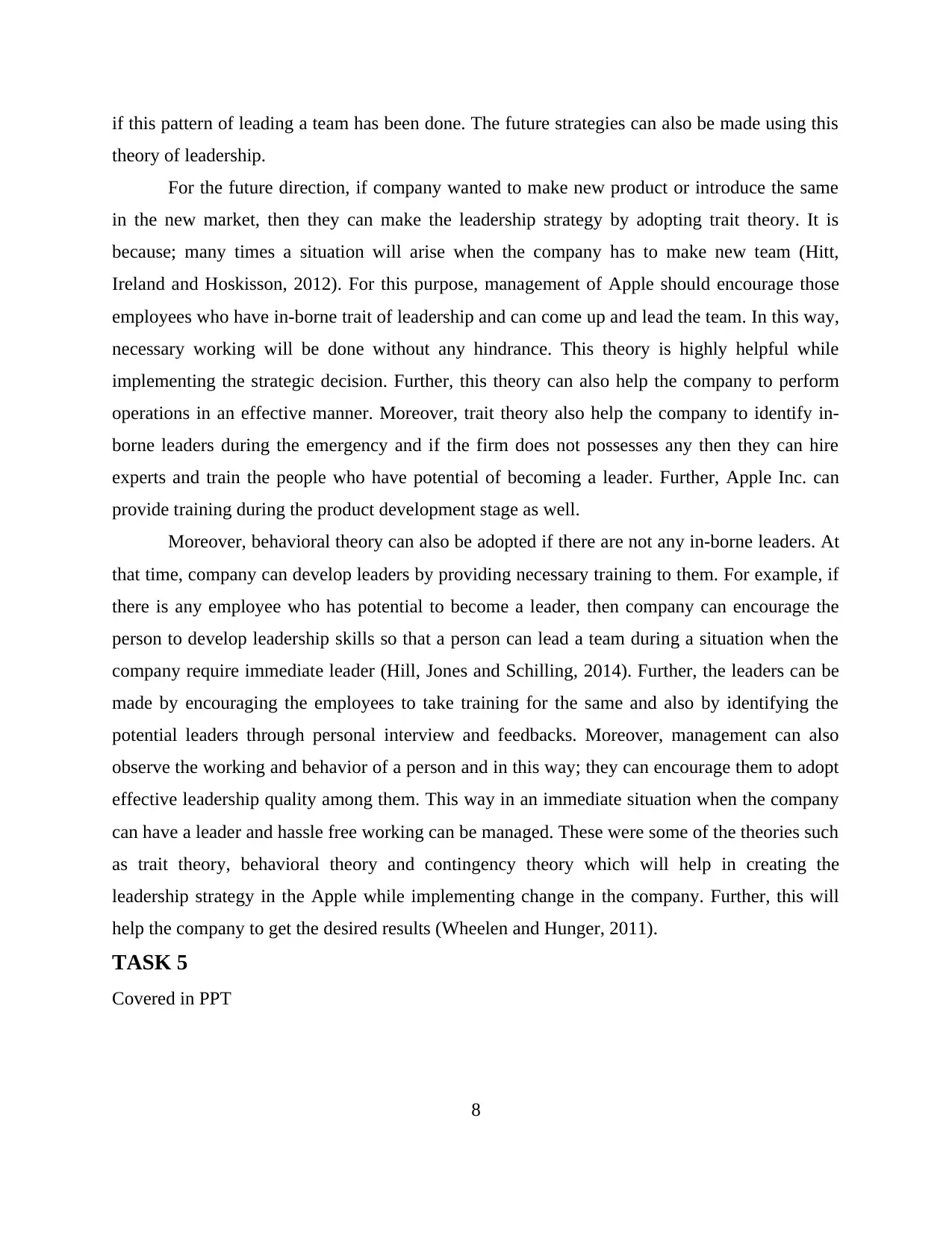
if this pattern of leading a team has been done. The future strategies can also be made using this
theory of leadership.
For the future direction, if company wanted to make new product or introduce the same
in the new market, then they can make the leadership strategy by adopting trait theory. It is
because; many times a situation will arise when the company has to make new team (Hitt,
Ireland and Hoskisson, 2012). For this purpose, management of Apple should encourage those
employees who have in-borne trait of leadership and can come up and lead the team. In this way,
necessary working will be done without any hindrance. This theory is highly helpful while
implementing the strategic decision. Further, this theory can also help the company to perform
operations in an effective manner. Moreover, trait theory also help the company to identify in-
borne leaders during the emergency and if the firm does not possesses any then they can hire
experts and train the people who have potential of becoming a leader. Further, Apple Inc. can
provide training during the product development stage as well.
Moreover, behavioral theory can also be adopted if there are not any in-borne leaders. At
that time, company can develop leaders by providing necessary training to them. For example, if
there is any employee who has potential to become a leader, then company can encourage the
person to develop leadership skills so that a person can lead a team during a situation when the
company require immediate leader (Hill, Jones and Schilling, 2014). Further, the leaders can be
made by encouraging the employees to take training for the same and also by identifying the
potential leaders through personal interview and feedbacks. Moreover, management can also
observe the working and behavior of a person and in this way; they can encourage them to adopt
effective leadership quality among them. This way in an immediate situation when the company
can have a leader and hassle free working can be managed. These were some of the theories such
as trait theory, behavioral theory and contingency theory which will help in creating the
leadership strategy in the Apple while implementing change in the company. Further, this will
help the company to get the desired results (Wheelen and Hunger, 2011).
TASK 5
Covered in PPT
8
theory of leadership.
For the future direction, if company wanted to make new product or introduce the same
in the new market, then they can make the leadership strategy by adopting trait theory. It is
because; many times a situation will arise when the company has to make new team (Hitt,
Ireland and Hoskisson, 2012). For this purpose, management of Apple should encourage those
employees who have in-borne trait of leadership and can come up and lead the team. In this way,
necessary working will be done without any hindrance. This theory is highly helpful while
implementing the strategic decision. Further, this theory can also help the company to perform
operations in an effective manner. Moreover, trait theory also help the company to identify in-
borne leaders during the emergency and if the firm does not possesses any then they can hire
experts and train the people who have potential of becoming a leader. Further, Apple Inc. can
provide training during the product development stage as well.
Moreover, behavioral theory can also be adopted if there are not any in-borne leaders. At
that time, company can develop leaders by providing necessary training to them. For example, if
there is any employee who has potential to become a leader, then company can encourage the
person to develop leadership skills so that a person can lead a team during a situation when the
company require immediate leader (Hill, Jones and Schilling, 2014). Further, the leaders can be
made by encouraging the employees to take training for the same and also by identifying the
potential leaders through personal interview and feedbacks. Moreover, management can also
observe the working and behavior of a person and in this way; they can encourage them to adopt
effective leadership quality among them. This way in an immediate situation when the company
can have a leader and hassle free working can be managed. These were some of the theories such
as trait theory, behavioral theory and contingency theory which will help in creating the
leadership strategy in the Apple while implementing change in the company. Further, this will
help the company to get the desired results (Wheelen and Hunger, 2011).
TASK 5
Covered in PPT
8
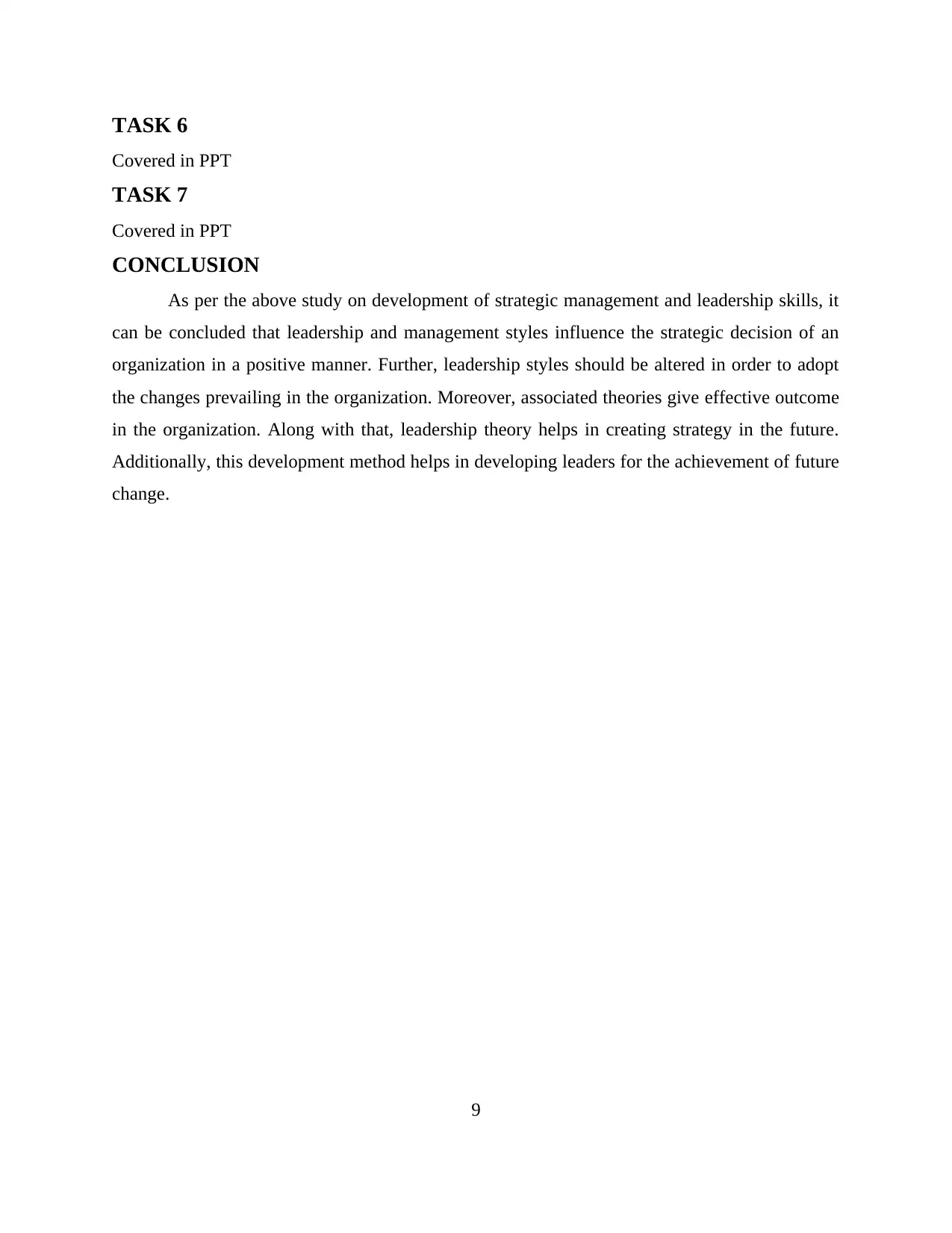
TASK 6
Covered in PPT
TASK 7
Covered in PPT
CONCLUSION
As per the above study on development of strategic management and leadership skills, it
can be concluded that leadership and management styles influence the strategic decision of an
organization in a positive manner. Further, leadership styles should be altered in order to adopt
the changes prevailing in the organization. Moreover, associated theories give effective outcome
in the organization. Along with that, leadership theory helps in creating strategy in the future.
Additionally, this development method helps in developing leaders for the achievement of future
change.
9
Covered in PPT
TASK 7
Covered in PPT
CONCLUSION
As per the above study on development of strategic management and leadership skills, it
can be concluded that leadership and management styles influence the strategic decision of an
organization in a positive manner. Further, leadership styles should be altered in order to adopt
the changes prevailing in the organization. Moreover, associated theories give effective outcome
in the organization. Along with that, leadership theory helps in creating strategy in the future.
Additionally, this development method helps in developing leaders for the achievement of future
change.
9
⊘ This is a preview!⊘
Do you want full access?
Subscribe today to unlock all pages.

Trusted by 1+ million students worldwide
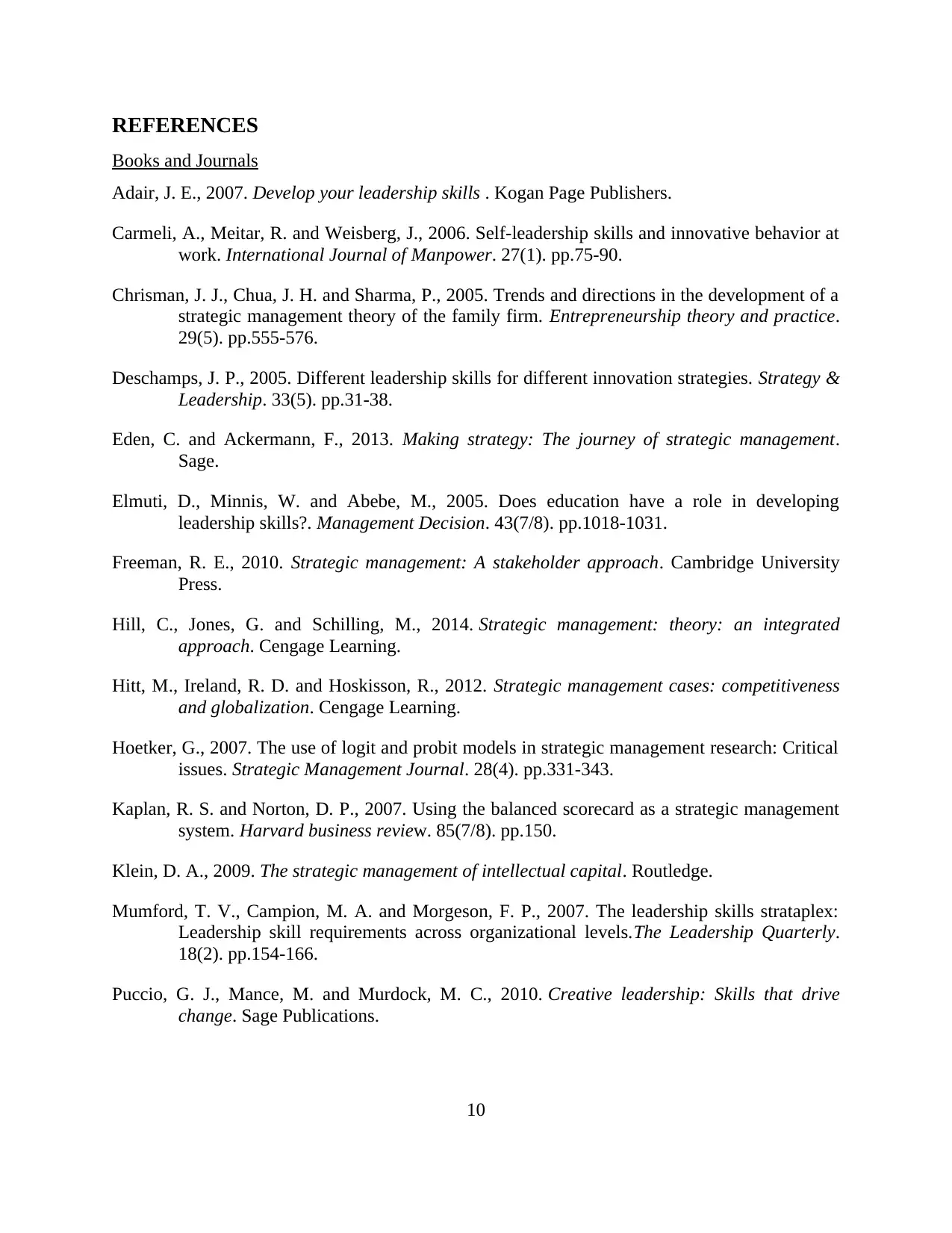
REFERENCES
Books and Journals
Adair, J. E., 2007. Develop your leadership skills . Kogan Page Publishers.
Carmeli, A., Meitar, R. and Weisberg, J., 2006. Self-leadership skills and innovative behavior at
work. International Journal of Manpower. 27(1). pp.75-90.
Chrisman, J. J., Chua, J. H. and Sharma, P., 2005. Trends and directions in the development of a
strategic management theory of the family firm. Entrepreneurship theory and practice.
29(5). pp.555-576.
Deschamps, J. P., 2005. Different leadership skills for different innovation strategies. Strategy &
Leadership. 33(5). pp.31-38.
Eden, C. and Ackermann, F., 2013. Making strategy: The journey of strategic management.
Sage.
Elmuti, D., Minnis, W. and Abebe, M., 2005. Does education have a role in developing
leadership skills?. Management Decision. 43(7/8). pp.1018-1031.
Freeman, R. E., 2010. Strategic management: A stakeholder approach. Cambridge University
Press.
Hill, C., Jones, G. and Schilling, M., 2014. Strategic management: theory: an integrated
approach. Cengage Learning.
Hitt, M., Ireland, R. D. and Hoskisson, R., 2012. Strategic management cases: competitiveness
and globalization. Cengage Learning.
Hoetker, G., 2007. The use of logit and probit models in strategic management research: Critical
issues. Strategic Management Journal. 28(4). pp.331-343.
Kaplan, R. S. and Norton, D. P., 2007. Using the balanced scorecard as a strategic management
system. Harvard business review. 85(7/8). pp.150.
Klein, D. A., 2009. The strategic management of intellectual capital. Routledge.
Mumford, T. V., Campion, M. A. and Morgeson, F. P., 2007. The leadership skills strataplex:
Leadership skill requirements across organizational levels.The Leadership Quarterly.
18(2). pp.154-166.
Puccio, G. J., Mance, M. and Murdock, M. C., 2010. Creative leadership: Skills that drive
change. Sage Publications.
10
Books and Journals
Adair, J. E., 2007. Develop your leadership skills . Kogan Page Publishers.
Carmeli, A., Meitar, R. and Weisberg, J., 2006. Self-leadership skills and innovative behavior at
work. International Journal of Manpower. 27(1). pp.75-90.
Chrisman, J. J., Chua, J. H. and Sharma, P., 2005. Trends and directions in the development of a
strategic management theory of the family firm. Entrepreneurship theory and practice.
29(5). pp.555-576.
Deschamps, J. P., 2005. Different leadership skills for different innovation strategies. Strategy &
Leadership. 33(5). pp.31-38.
Eden, C. and Ackermann, F., 2013. Making strategy: The journey of strategic management.
Sage.
Elmuti, D., Minnis, W. and Abebe, M., 2005. Does education have a role in developing
leadership skills?. Management Decision. 43(7/8). pp.1018-1031.
Freeman, R. E., 2010. Strategic management: A stakeholder approach. Cambridge University
Press.
Hill, C., Jones, G. and Schilling, M., 2014. Strategic management: theory: an integrated
approach. Cengage Learning.
Hitt, M., Ireland, R. D. and Hoskisson, R., 2012. Strategic management cases: competitiveness
and globalization. Cengage Learning.
Hoetker, G., 2007. The use of logit and probit models in strategic management research: Critical
issues. Strategic Management Journal. 28(4). pp.331-343.
Kaplan, R. S. and Norton, D. P., 2007. Using the balanced scorecard as a strategic management
system. Harvard business review. 85(7/8). pp.150.
Klein, D. A., 2009. The strategic management of intellectual capital. Routledge.
Mumford, T. V., Campion, M. A. and Morgeson, F. P., 2007. The leadership skills strataplex:
Leadership skill requirements across organizational levels.The Leadership Quarterly.
18(2). pp.154-166.
Puccio, G. J., Mance, M. and Murdock, M. C., 2010. Creative leadership: Skills that drive
change. Sage Publications.
10
Paraphrase This Document
Need a fresh take? Get an instant paraphrase of this document with our AI Paraphraser
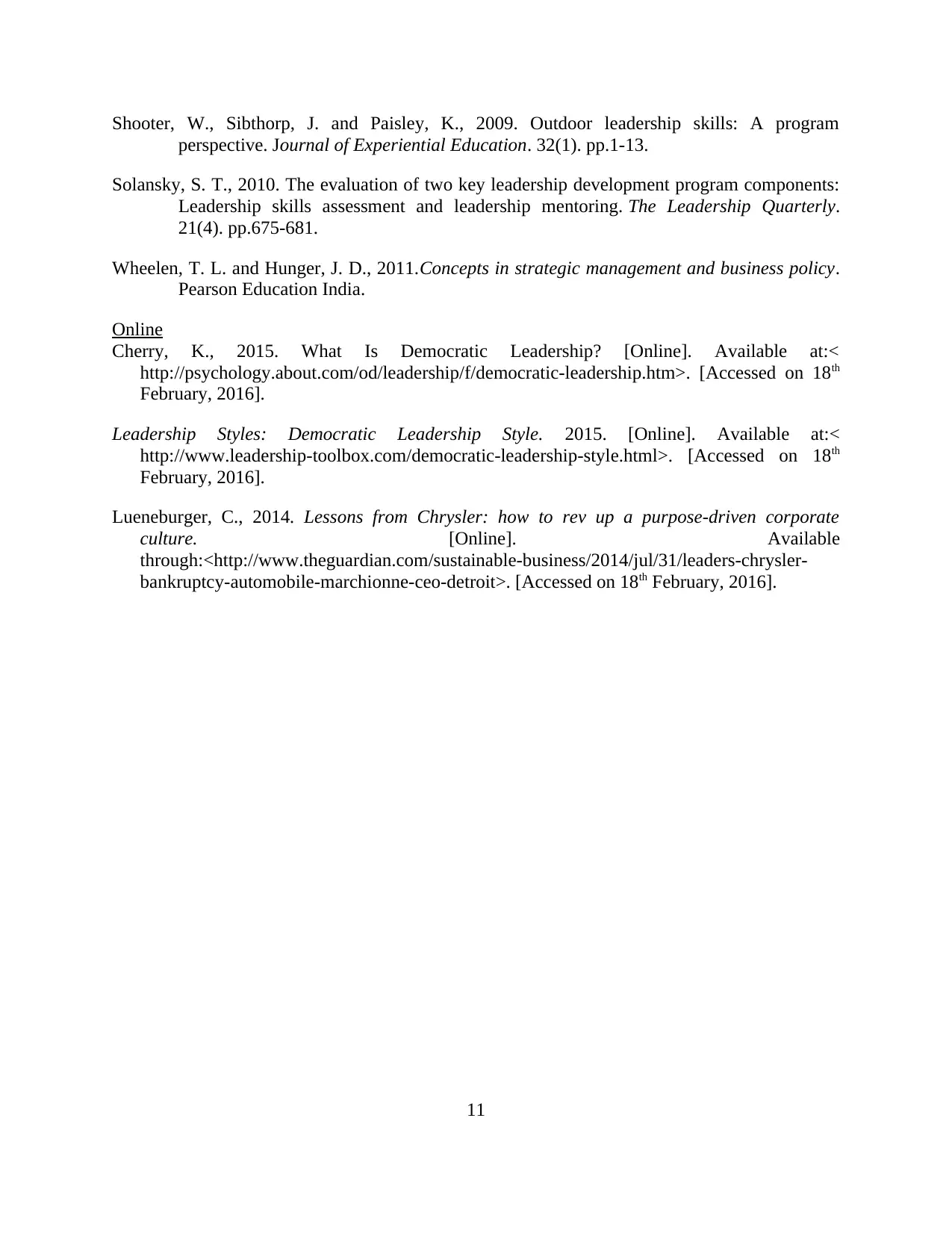
Shooter, W., Sibthorp, J. and Paisley, K., 2009. Outdoor leadership skills: A program
perspective. Journal of Experiential Education. 32(1). pp.1-13.
Solansky, S. T., 2010. The evaluation of two key leadership development program components:
Leadership skills assessment and leadership mentoring. The Leadership Quarterly.
21(4). pp.675-681.
Wheelen, T. L. and Hunger, J. D., 2011.Concepts in strategic management and business policy.
Pearson Education India.
Online
Cherry, K., 2015. What Is Democratic Leadership? [Online]. Available at:<
http://psychology.about.com/od/leadership/f/democratic-leadership.htm>. [Accessed on 18th
February, 2016].
Leadership Styles: Democratic Leadership Style. 2015. [Online]. Available at:<
http://www.leadership-toolbox.com/democratic-leadership-style.html>. [Accessed on 18th
February, 2016].
Lueneburger, C., 2014. Lessons from Chrysler: how to rev up a purpose-driven corporate
culture. [Online]. Available
through:<http://www.theguardian.com/sustainable-business/2014/jul/31/leaders-chrysler-
bankruptcy-automobile-marchionne-ceo-detroit>. [Accessed on 18th February, 2016].
11
perspective. Journal of Experiential Education. 32(1). pp.1-13.
Solansky, S. T., 2010. The evaluation of two key leadership development program components:
Leadership skills assessment and leadership mentoring. The Leadership Quarterly.
21(4). pp.675-681.
Wheelen, T. L. and Hunger, J. D., 2011.Concepts in strategic management and business policy.
Pearson Education India.
Online
Cherry, K., 2015. What Is Democratic Leadership? [Online]. Available at:<
http://psychology.about.com/od/leadership/f/democratic-leadership.htm>. [Accessed on 18th
February, 2016].
Leadership Styles: Democratic Leadership Style. 2015. [Online]. Available at:<
http://www.leadership-toolbox.com/democratic-leadership-style.html>. [Accessed on 18th
February, 2016].
Lueneburger, C., 2014. Lessons from Chrysler: how to rev up a purpose-driven corporate
culture. [Online]. Available
through:<http://www.theguardian.com/sustainable-business/2014/jul/31/leaders-chrysler-
bankruptcy-automobile-marchionne-ceo-detroit>. [Accessed on 18th February, 2016].
11
1 out of 11
Related Documents
Your All-in-One AI-Powered Toolkit for Academic Success.
+13062052269
info@desklib.com
Available 24*7 on WhatsApp / Email
![[object Object]](/_next/static/media/star-bottom.7253800d.svg)
Unlock your academic potential
Copyright © 2020–2025 A2Z Services. All Rights Reserved. Developed and managed by ZUCOL.




